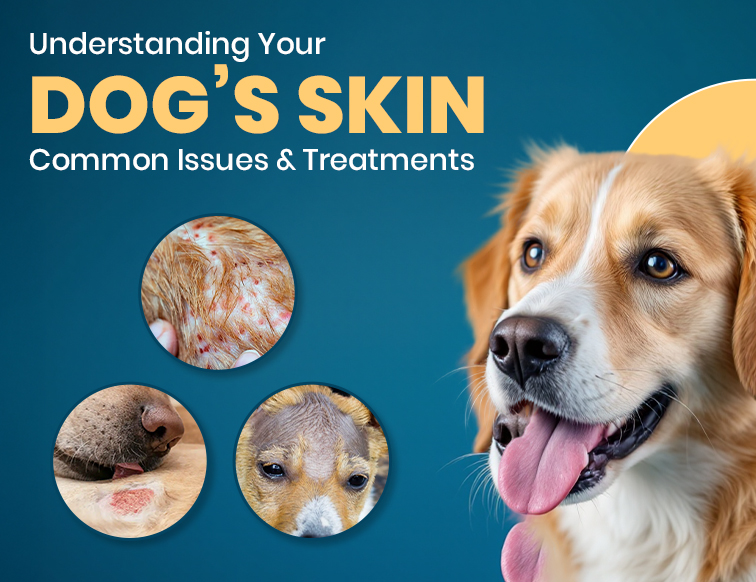Understanding Your Dog’s Skin – Common Issues & Treatments

Are you also confused and worried at the same time, seeing your canine companion scratching incessantly and wondering what’s bothering them? One of the most common yet overlooked problems in dogs is their skin and coat problems. Yes, our beloved four-legged friends often experience skin and coat issues that not only cause itching and discomfort but also lead to serious health issues if left unattended. Healthy skin reflects a healthy pet as it boosts immune health, acts as a protective barrier against outside pathogens and maintains overall well-being.
Let’s get into the details to explore the skin problems dogs encounter, along with their common symptoms and treatment and prevention tips. Keep reading to learn more.
Common dog skin & coat issues
Mentioned below are some common skin problems dogs experience and as a pet parent, you should be aware of them:
Allergic dermatitis:
Allergic dermatitis is a skin condition, mainly caused by food and environmental allergens. Environmental triggers such as pollen, dust mites, grass, soil, etc., and foods including soy, wheat, protein, etc., are some of the commonly known stimulators. The condition is characterized by red and inflamed skin, intense scratching, recurrent infections, etc.
Alopecia:
Alopecia (hair loss) is a condition with complete or partial loss of fur. Common signs include bald patches, itchy skin, extreme irritation, etc. It can be caused by genetic disorders, parasitic infestations, allergens, autoimmune diseases and hypothyroidism.
Mange infections:
Mange infections are caused by mites that penetrate deep into the hair follicles and skin of the dog, resulting in skin thickening and hair loss around the eyes, ears and legs. Demodex and Sarcoptes are the two primary types of mites, transmitted through direct contact with infected animals or environments.
Ringworms:
Ringworm is a fungal infection affecting dogs with a weakened immune system. It is usually seen as ring-shaped patches of hair loss, red or itchy skin or pus-filled lesions.
Fleas and ticks:
Fleas and ticks are external parasites that remain attached to the dog’s skin and feed on their blood. They not only cause pain, itching and discomfort but also lead to harmful diseases, including Lyme disease, anemia, flea allergy dermatitis, Rocky Mountain spotted fever, etc.
Seborrhea:
Seborrhea is a skin disorder often caused by excess sebum production (an oily substance secreted by the skin glands), leading to extreme flakiness, foul-skin odor, redness and greasy skin. It is usually caused by genetics, hormonal imbalances or certain allergies.
Bacterial or yeast infections:
Bacterial or yeast infections are commonly caused by an overgrowth of yeast or bacteria on the skin, resulting in redness, itching, chewing, scratching and greasy discharge. Hormonal imbalances, certain allergies or underlying skin conditions are some of the most common factors that contribute to yeast or bacterial overgrowth.
Symptoms of canine skin issues
Here are a few common signs of skin and coat problems in dogs:
- Excessive paw licking or chewing
- Circular patches on the skin
- Red or inflamed skin
- Recurrent ear infections
- Persistent itching or scratching
- Hair loss, especially around eyes, ears and legs
- Dry, dull and thin coat
- Skin dandruff or flakiness
- Red, moist skin lesions
- Foul-smelling skin
- Skin scabbing or thickening
- Hot spots or open sores
- Behavioral changes
Treatment & Prevention
Let’s have a quick rundown on the treatment and prevention methods you can consider for keeping your dog in good trim:
Shampoos and sprays: Various skin and coat shampoos and sprays are available in the market that help treat dry skin in dogs, as well as aid in dog skin rash treatment. Consider a pet-friendly shampoo that suits your canine while addressing their skin problems.
Supplements and skin balms: Consider using omega-3 & omega-6 supplements and skin balms or lotions made from natural ingredients to support and maintain healthy skin and coat.
Flea and tick prevention: Fleas and ticks cause multiple skin issues and therefore, year-round prevention is paramount. Flea and tick solutions in the form of oral, topical and collar are available, so choose the one that is easily accepted by your dog and keep them free from these parasites.
Environmental and dietary changes: Various environmental and food triggers cause allergies in dogs, leading to extreme itching and irritation. Therefore, focus on identifying the allergens and make modifications in their environment as well as diet to prevent skin problems.
Keep an eye on the symptoms: Watching your dog closely and keeping an eye on the signs your dog exhibits helps in early detection. Hence, do not ignore anything unusual; missing a subtle sign can sometimes lead to a life-threatening condition.
Vacuum beddings regularly: Parasites such as fleas, ticks, mites and certain allergens tend to hide in the beddings, furniture and other areas of the house, causing skin problems in dogs. Therefore, maintaining proper hygiene by regularly vacuuming the beddings and cleaning the house is essential to keep skin issues away.
Schedule routine vet visits: Taking your canine companion for routine vet visits helps in diagnosing any skin disease at an early stage and provides timely treatment before the condition advances. Consider scheduling an annual or bi-annual wellness examination to ensure the sound health and well-being of your furry companion.
Browse through the extensive collection of skin health supplements for dogs to ensure comprehensive health and overall well-being.

When to consult the vet…
Dog skin issues are quite common and nothing to worry about, as they are very much treatable and preventable with a little effort and the right approach. Learning about the causes, symptoms and treatments of skin problems goes a long way in keeping your little one hale and hearty. However, if the symptoms aggravate or remain persistent, consult the veterinarian immediately to ensure the longevity and vitality of your furball.
